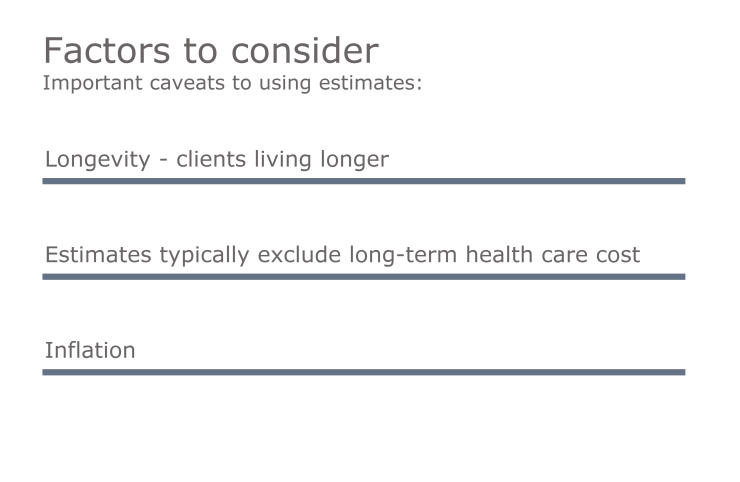There are some frightening numbers to navigate when estimating health care costs during retirement and they can be overwhelming to clients:
So what are people to make of these estimates and how should advisers help clients plan for them?
Health care costs are one of the largest—and potentially most variable—expenses in retirement. Unfortunately, many clients either ignore these expenses when they make a retirement income plan or make woefully inadequate estimates. A study of almost 2,000 adults by Fidelity Investments found that 48% of respondents estimated they would spend $50,000 per person for health care in retirement.
That's a low number according to most published research. Most data illustrates a starkly different scenario, suggesting substantially higher costs.
NOT AS SIMPLE AS PAINTING BY NUMBERS
Some sources paint a pretty picture while others paint abstract confusion: Fidelity, EBRI, Healthview and the Department of Labor all publish prominent estimates. Unfortunately, the reporting formats vary and comparing estimates can be confusing especially for the casual reader.

They found retirement health care costs for a 65-year-old couple retiring this year are approximately $260,000 based on life expectancies of 85 and 87 for the husband and wife respectively, according to Fidelity Investments' 2016 Retirement Assessment Survey.
Its annual estimates actually decreased from $250,000 in 2010, to $220,000 in 2014 before resuming an upward climb. The temporary drop was attributed to lower utilization of health care and smaller payment increases to providers. Drug costs rose more than 9% last year and are likely contributing to the renewed cost increases, according to The Wall Street Journal.
-
While many are woefully uninformed about the mechanics of Social Security, better information alone is not enough to guarantee better claiming behavior.
October 24 -
Tiny COLA increases set for 2017; taxable earnings threshold also raised, making tax less regressive.
October 18 -
Failed marriages for aging baby boomers has doubled, forcing them to work longer and impacting financial planning, sometimes in the wrong way.
October 18
Healthview Services’ estimates are a bit higher. Its 2016 annual report of retirement health care costs concludes that a 65-year-old couple today would need $377, 412 of savings (current value) to cover total retirement health care costs.
Unless you are a trained statistician, you might not love The Employee Benefit Research Institute’s estimates. Results are reported in terms of median drug expenses, percentiles of drug expenditures and probabilities of success. Ouch!

EBRI estimates lifetime retirement health care spending of $259,000 for a 65-year-old couple retiring in 2015, assuming median drugs costs and a 90% success rate of holding at this level of spending. But health care spending is highly dependent on drug costs. A couple pushed into the 90th percentile of drug costs – well beyond the median – and the estimate of health care spending soars to some $392,000.
FACTORING INFLATION AND LONGEVITY
Finally, we come to some actual reported spending. Households with a primary responder older than 65, averaged almost $6,000 a year in health care expenses, according to the U.S. Government Bureau of Labor Statistics' Consumer Expenditure Survey. These households had an average of 1.4 people over age 65. Seems like typical government reporting style – a little weird trying to put 1.4 people into a useful context but it uses real numbers rather than estimates.

There are three important caveats to these estimates: Life expectancy, personal health variables and inflation.
- Longevity – Most estimates presume average life expectancies of about 82 years for men and 85 for women. Clients who have a family history of longer life spans should pad the numbers accordingly.
- Estimates typically exclude long-term care costs for late-life health and personal care. They also do not include dental, vision and other out-of-pocket expenses.
- Inflation – This is the big enchilada. The compounding effect of inflation is huge and differences in assumed inflation rates dramatically affect lifetime spending estimates. Healthview estimates health care inflation of 6% for the next 10 years.
While the sector has been in a slump, advisors who go beyond the recent returns can show clients how these funds have bested the S&P 500 over time.
The compounding effect is especially important for advisers who use cash-flow-based planning and project year-by-year expenses. For instance, a mere 1% increase in projected Social Security cost-of- living adjustments caused Healthview to reduce the amount of Social Security required to pay for health care from 67% in 2015, to 57% in 2016.
Other variables include geography and income. For example, spending will be higher in New York than in South Dakota.
Income level matters. Clients with more wealth will spend more on health care. Be careful to note if estimates are expressed in current value dollars or future dollars, with the assumed inflation rate being the difference.
After wading through the data and making sense of it all, advisers need to take the next step and make retirement health care costs comprehensible and actionable for clients.






